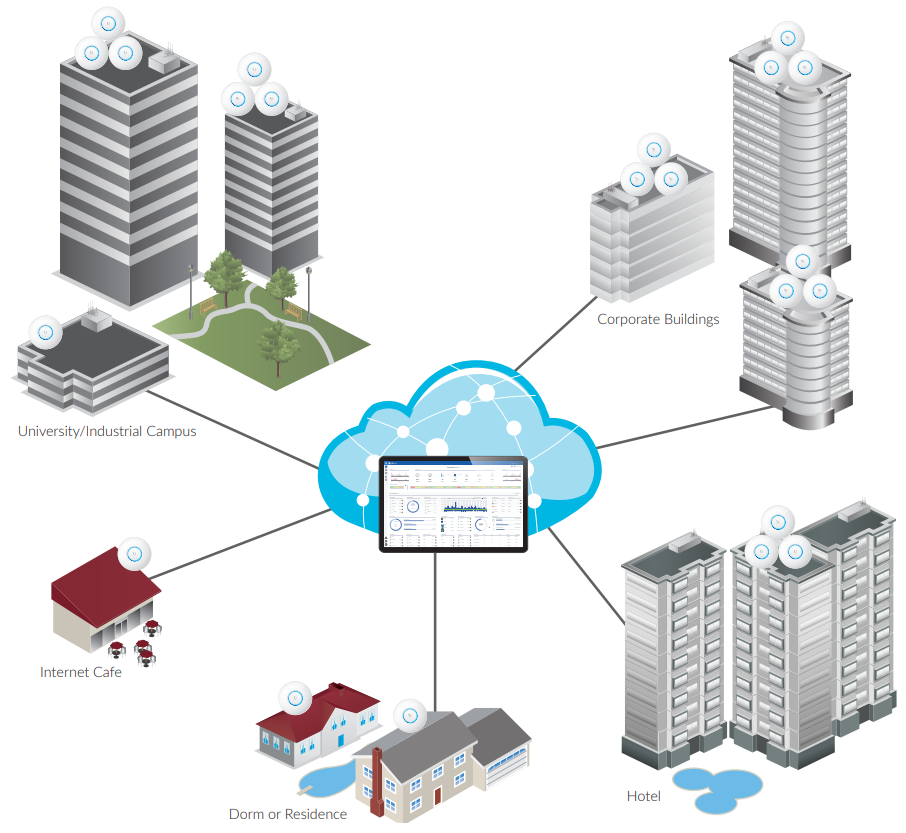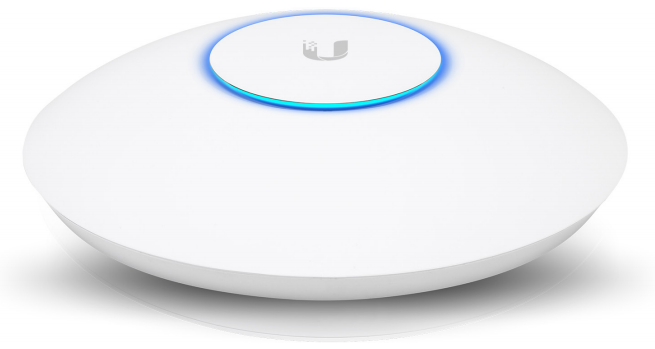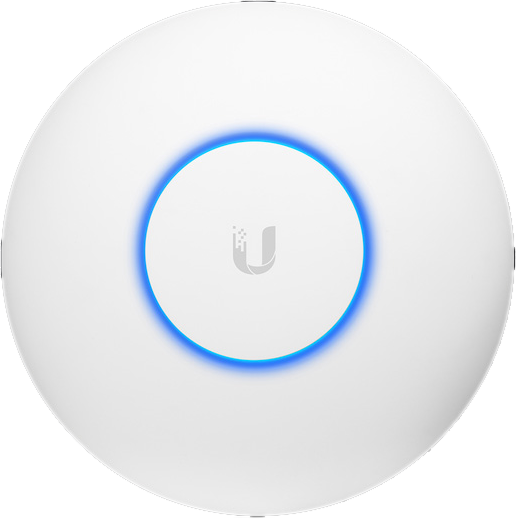Overview:
The UniFi® Ecosystem enables the system integrator to
effectively and efficiently create wireless network designs
of any size, from small to large, with the potential for
unlimited scalability.
The built-in, dedicated security and monitoring radio of
the UniFi XG AP provides visibility into site performance,
channel planning, and local interferers, allowing the
integrator to properly evaluate performance and quickly
respond to changing interference and security threat
landscapes.
Easily accessible through any standard web browser and
the UniFi app (iOS or Android™), the UniFi Controller
software is a powerful software engine ideal for highdensity client deployments requiring low latency and high
uptime performance.
Features
Powerful Hardware: The UniFi XG AP features the
latest in Wi-Fi 802.11ac Wave 2 MU‑MIMO technology
combined with dedicated security and Bluetooth radios.
Intuitive UniFi Controller Software: The system
integrator can leverage the controller to easily configure
and administer an enterprise Wi-Fi network.
Expandable: The system integrator can start with one (or
upgrade to a multi‑pack) and expand to thousands while
maintaining a single unified management system.
Save Money and Save Time: UniFi comes bundled with
a software controller that can be deployed on an on-site
PC, Mac, or Linux machine; in a private cloud; or using a
public cloud service.
Extend Your Coverage
With the UniFi Controller software running in a NOC or in the cloud, system integrators can manage multiple sites: multiple,
distributed deployments and multi-tenancy for managed service providers. Below are some deployment examples:

Features:

Packed with Features
The UniFi Controller can provision
thousands of UniFi APs, map out
networks, quickly manage system
traffic, and add more UniFi APs.
View Your RF Environment
Use the RF environment functionality
of the UniFi XG AP to detect and
troubleshoot nearby interference,
analyze radio frequencies, choose
optimal AP placement, and
configure settings.
Powerful RF Performance
Features
Advanced RF performance and
configuration features include spectral
analysis, airtime fairness, and band
steering.
Detailed Analytics
The UniFi Controller provides
configurable reporting and analytics
to manage large user populations
and expedite troubleshooting by the
system integrator.
WLAN Groups
Manage flexible configurations of
large deployments. Create multiple
WLAN groups and assign them to an
AP’s radio. Each WLAN can be VLAN
tagged. Dynamic VLAN tagging per
Wi-Fi station (or RADIUS VLAN) is
also supported.
Wireless Uplink
Wireless Uplink functionality enables
wireless connectivity between APs
for extended range. One wired UniFi
AP uplink supports up to four wireless
downlinks on a single operating band,
allowing wireless adoption of devices
in their default state and real-time
changes to network topology.
Multi-Site Management
A single UniFi Controller running in
the cloud can manage multiple sites:
multiple, distributed deployments
and multi-tenancy for managed
service providers. Each site is
logically separated and has its own
configuration, maps, statistics, guest
portal, and administrator accounts.
Guest Portal/Hotspot
Support
Use the UniFi Controller to quickly
customize the configuration for Guest
Portals, including authentication,
Hotspot setup, and the option to use
your own external portal server.
For your Guest Portal/Hotspot
package offerings, take advantage of
UniFi's rate limiting capabilities. Apply
different bandwidth rates (download/
upload), limit total data usage, and
limit duration of use.
All UniFi APs include Hotspot
functionality:
- Built-in support for billing
integration using major credit cards.
- Built-in support for voucher‑based
authentication, including the ability
to generate voucher codes.
- Built-in Hotspot Manager
for voucher creation, guest
management, and payment refunds.
- Full customization and branding of
Hotspot portal pages, including use
of your own logo.

Hardware Overview:
Deploy the UniFi XG AP in very high-density
environments requiring maximum wireless performance.
The UniFi XG AP features simultaneous, dual-band, 4x4
MU-MIMO technology and convenient 802.3bt PoE
compatibility. Available in single- and five‑packs.
Quad-Radio Capabilities: Three client radios deliver
unparalleled Wi-Fi performance while a dedicated security
radio provides persistent threat management.
Superior Processing Power: The UniFi XG AP is capable
of complex operations (guest control, filtering, and
other resource-intensive tasks) that may slow down a
lesser‑equipped AP.
10G and 1G Ethernet Connectivity: Designed to be a
10G Ethernet backhaul, the primary port carries both data
and PoE, while the secondary Gigabit Ethernet port is for
bridging and also supports PoE input.
Power over Ethernet (PoE) Standard: The UniFi XG AP
can be powered by an 802.3bt PoE compliant switch.
Easy Mounting: Its sleek design seamlessly integrates
into any environment (all accessories included) and is
compatible with existing UAP-AC-PRO mounts.
LED: The unique LED provisioning ring provides
administrator location tracking and alerts for each device.
Specifications:
| UAP-XG |
| Dimensions |
228 x 228 x 50 mm (8.98 x 8.98 x 1.97") |
Weight
With Mounting Kits |
1.20 kg (2.65 lb)
1.35 kg (2.98 lb) |
| Networking Interface |
(1) 10/100/1000 Ethernet Port
(1) 1/10 Gbps ICM Ethernet Port |
| Buttons |
Reset |
| Power Method |
802.3bt PoE |
| Supported Voltage Range |
44 to 57VDC |
| Power Supply |
PoE Injector 50VDC, 1.2A Gigabit |
| Power Save |
Supported |
| Beamforming |
Supported |
| Maximum Power Consumption |
31W |
| Radios |
2.4 GHz, (2) 5 GHz, Security |
Maximum TX Power
2.4 GHz
5 GHz |
25 dBm
25 dBm |
Antennas
2.4 GHz
5 GHz |
(2) Dual-Port, Dual-Polarity Antennas, 6 dBi each
(2) Dual-Port, Dual-Polarity Antennas, 8 dBi each |
| Wi-Fi Standards |
802.11 a/b/g/n/ac/ac-wave2 |
| Wireless Security |
WEP, WPA-PSK, WPA-Enterprise (WPA/WPA2, TKIP/AES), 802.11 w/PMF |
| BSSID |
Up to 8 per Radio |
| Mounting |
Wall/Ceiling/Junction Box (Kits Included) |
| Operating Temperature |
-10 to 60° C (14 to 140° F) |
| Operating Humidity |
5 to 95% Noncondensing |
| Certifications |
CE, FCC, IC |
| Advanced Traffic Management |
| VLAN |
802.1Q |
| Advanced QoS |
Per-User Rate Limiting |
| Guest Traffic Isolation |
Supported |
| WMM |
Voice, Video, Best Effort, and Background |
| Concurrent Clients |
1500 |
| Supported Data Rates (Mbps) |
| Standard |
Data Rates |
| 802.11ac |
6.5 Mbps to 1.7 Gbps (MCS0 - MCS9 NSS1/2/3/4, VHT 20/40/80) |
| 802.11n |
6.5 Mbps to 450 Mbps (MCS0 - MCS23, HT 20/40) |
| 802.11a |
6, 9, 12, 18, 24, 36, 48, 54 Mbps |
| 802.11g |
6, 9, 12, 18, 24, 36, 48, 54 Mbps |
| 802.11b |
1, 2, 5.5, 11 Mbps |
Technology:
802.11ac Technology
Initial 802.11ac Wave 1 SU-MIMO (Single-User,
Multiple Input, Multiple Output) technology allows an
earlier‑generation AP, such as the UniFi AC Pro AP, to
communicate with only one client at a time.
802.11ac Wave 2 MU‑MIMO (Multi-User, Multiple Input,
Multiple Output) technology allows a Wave 2 AP, such
as the UniFi XG AP, to communicate with multiple clients
at the same time – significantly increasing multi‑user
throughput and overall user experience.
MU-MIMO Assuming the same conditions, a Wave 2
radio provides up to 75% improvement1 beyond a Wave 1
radio. This improvement increases wireless performance
and/or serves more clients at the same performance level.
4x4 Spatial Streams At any single time, a Wave 2 radio
can communicate with the following MU-MIMO clients:
- four 1x1 clients
- two 2x2 clients
- one 2x2 client and two 1x1 clients
- one 3x3 client and one 1x1 client
Real-World Performance Combining twice the number
of 5 GHz radios and four times the associations per radio,
the UniFi XG AP delivers an order of magnitude more
performance1 than a typical 802.11ac Wave 1 AP.
Client Compatibility For optimal performance, use
MU‑MIMO clients. SU‑MIMO clients will also benefit and
gain up to 10‑20% greater performance when used with
the UniFi XG AP.
Application Scenarios
For very high-density environments, such as a large
auditorium or concert hall containing numerous clients in
a relatively small space, we recommend the UniFi XG AP.
Wave 1 and Wave 2 APs offer 28 independent
(non‑overlapping) channels: three for the 2.4 GHz band
and twenty-five for 5 GHz, including DFS channels.
When you use the 2.4 GHz band in a high‑density
location, you encounter self-interference and channel
saturation. When you use the 5 GHz band, you can
deploy smaller cells (coverage areas), so you can support
more clients in any cell that deploys more than one AP.
With the advantages of MU-MIMO technology and
4x4 spatial streams, the UniFi XG AP can support more
than triple the number of users2 per radio than a typical
Wave 1 AP.









